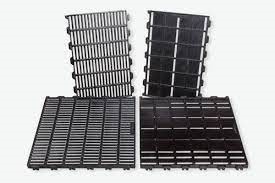I was at a STEM Festival last autumn, where we were demonstrating our Feed Sacks Pork Lesson. Students create a snack combination based on the feed rations a pig receives in this exercise. We had some pictures of contemporary pig slat floor barns on the table as part of our setup, along with some actual samples of pig feed.
One family was quite interested in what they saw when they visited our booth at this event. They informed me that they had just relocated from Alabama to Iowa and had no prior knowledge of the state’s agricultural industry.
The mother questioned why the floors seemed the way they did after seeing one of the images. I thought this was a fantastic question since many people don’t have the chance to go inside the pig barns they see from the road. Why is pig flooring barn constructed in the manner they are?
Slatted flooring, or long, thin slots on the floor, is used in pig barns. In essence, this establishes a mechanism for disposing of excrement in the barn, preventing the pigs from having to lie about in messes. As opposed to routinely scooping or removing the trash, this approach requires a lot less work.
The appearance of slatted flooring might vary. The floor in the image above is made of cement. Similar-looking flooring systems might also be made of rubber-coated metal or plastic. Depending on the cost, the size of the barn, and how safe the flooring will be for the pigs, various producers or barns may employ various flooring types.
What transpires, though, to the trash that leaks through the floor? Does it just drop to the floor and remain there? Not exactly! Manure pits may be seen underneath pig slat floor barns like this. In other kinds of barns, the manure is transferred to a pit outside the building rather than immediately below it. A close eye is kept on the air quality in each of these pits to ensure that no incidents occur that may endanger people or the pigs. Occasionally, the gas may be captured and turned into biogas, which can power the farm!
What happens to the manure after that? These pits are drained out onto tanker trucks twice a year, and the manure is then utilized as fertilizer for agricultural areas. To ensure that the farmer applies the proper quantity of manure to the field, manure and the soil from the fields may both be analyzed for nutrients. Manure is primarily rich in nitrogen, but it is also rich in other minerals necessary for plant development, including phosphorus and potassium.
Modern manure pits contain waste as a slurry, which means it is mostly liquid. Because of this, moving about and applying to the field is made simple. Nowadays, a lot of farmers would inject manure into the soil rather than spread it on top. There are many advantages to this. The first benefit is that the excrement will be less exposed to the weather and less likely to wash into a neighboring stream as a result. Second, infusing the manure into the soil aids in stabilizing the nitrogen for a longer time. If the nitrogen was given topically, it would be more prone to volatilization, pig farm equipment which means it may change quickly into a form of nitrogen that plants can’t use.
Manure management refers to the whole process of handling livestock’s unkempt side. It may also include creative and intriguing approaches to odor management, such as the use of windbreaks or even the construction of air biofilters from materials like woodchips.
Despite its unpleasant stench, manure is an important component of Iowan agriculture. In addition to producing fertilizer for our crops, we also raise crops to feed our cattle. Do you agree that it is an exquisite method for a less-than-elegant subject?
What additional inquiries do you have about agriculture? If you let us know in the comments, we could answer your query in the future “Why do they do that?” blog post!\
Visit also ibomma for more interesting articles.

